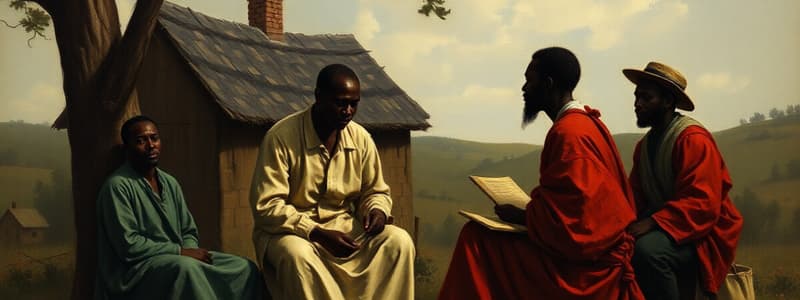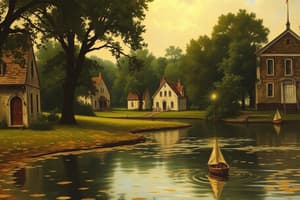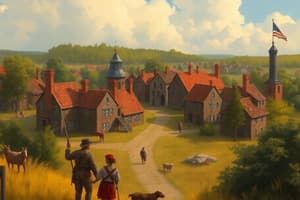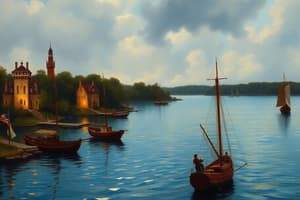Podcast
Questions and Answers
Explain how the Calvert brothers learned from the Jamestown colony's struggles when planning the Maryland colony?
Explain how the Calvert brothers learned from the Jamestown colony's struggles when planning the Maryland colony?
The Calvert brothers planned the Maryland colony carefully to avoid the 'starving time' that Jamestown experienced.
What were the two primary motivations behind the founding of the Maryland Colony by the Calverts?
What were the two primary motivations behind the founding of the Maryland Colony by the Calverts?
The Calverts wanted to establish a colony to generate income and to provide a refuge for Catholics facing religious persecution in England.
Describe the role of indentured servants in the early settlement of Maryland.
Describe the role of indentured servants in the early settlement of Maryland.
Indentured servants made up the majority of the first group of colonists sent to Maryland, providing a significant labor force for the colony's initial development.
How did Cecilius Calvert become the owner of the Maryland colony?
How did Cecilius Calvert become the owner of the Maryland colony?
In what ways were the Maryland and Virginia colonies similar?
In what ways were the Maryland and Virginia colonies similar?
Flashcards
Maryland Colony
Maryland Colony
A colony founded by the Calverts as a refuge for Catholics and to generate income.
The Calverts
The Calverts
Wealthy English landowners who founded the Maryland Colony.
George Calvert
George Calvert
Also known as Lord Baltimore, he invested in the Virginia Company and sought a charter for Maryland.
Cecilius Calvert
Cecilius Calvert
Signup and view all the flashcards
First Maryland Colonists
First Maryland Colonists
Signup and view all the flashcards
Study Notes
- The Maryland Colony was founded by the Calverts, a wealthy English Catholic family.
- The Calverts wanted to create a profitable colony and a refuge for Catholics, who faced religious restrictions in England.
The Calverts
- George Calvert, also known as Lord Baltimore, had invested in the Virginia Company.
- George Calvert requested King Charles I for a charter to establish a new colony north of Virginia, along the Chesapeake Bay.
- George Calvert passed away in 1632, before King Charles I signed the charter.
- Cecilius Calvert, George's oldest son, inherited the title of Lord Baltimore and became the owner of the new colony.
- Cecilius Calvert named the colony Maryland.
- Cecilius Calvert chose his brother, Leonard, to be Maryland's first governor.
- The Calvert brothers learned from the difficulties faced in Jamestown, Virginia.
- In 1633, the Calverts dispatched the first group of colonists to Maryland, primarily indentured servants.
- Settlers landed near the Potomac River's mouth, establishing St. Mary's City, their first settlement.
Life in Maryland and Virginia
- Maryland and Virginia shared similarities, including a mild climate and fertile soil suitable for tobacco cultivation along the Coastal Plain
- Some Maryland colonists prospered growing tobacco on expansive plantations.
- Many colonists struggled on small farms, frequently starting as indentured servants.
- The Maryland government supported former servants with land, clothing, tools, and corn.
Government
- Virginia became the largest English colony in North America in the early 1700s.
- Williamsburg became Virginia's capital in 1699.
- Virginia and Maryland had similar governmental structures, with governors and elected assemblies.
- Virginia was a royal colony under the king's control, while Maryland was a proprietary colony controlled by the Calverts.
- In 1649, Maryland enacted the Toleration Act, granting religious freedom to all Christians in the colony.
- The Anglican Church became Maryland's official church in 1702.
The Carolina Colonies
- Colonists migrated south from Maryland and Virginia in search of more land.
- King Charles II granted land for a new colony called Carolina in 1663.
Lords Proprietors
- The Carolina charter divided the land among eight English leaders called the Lords Proprietors.
- In 1669, the Lords Proprietors established a constitution, or written plan of government.
- The Carolina Colony allowed free White male colonists to elect leaders and enact certain laws while giving most of the power to the proprietors and the king.
- There were governance challenges in the Carolina Colony, leading to the colony split into North Carolina and South Carolina in 1712.
- North Carolina farmers grew tobacco and corn in hilly areas.
- South Carolina farmers faced difficulties growing tobacco due to the wet land.
- Enslaved African workers introduced successful rice cultivation methods.
- Rice became South Carolina's primary crop, significantly increasing the enslaved population.
Georgia
-
England, France, and Spain all lay territorial claim to areas south of South Carolina.
-
By 1727, King George II sought to establish colonies in the in the area to maintain control.
-
James Oglethorpe offered to send debtors from English prisons to settle a new colony.
-
The new settlers would defend the land and Oglethorpe hoped the debtors would get a chance to start a new life.
-
King George II granted Oglethorpe a charter for Georgia, the last of the 13 English Colonies.
-
Georgia was named in the king's honor.
-
The first colonists founded Savannah in 1733.
Slavery
- Georgia initially restricted farm sizes and prohibited slavery
- The settlers had divided opinions regarding slavery.
- Georgia's leaders legalized slavery in 1751.
- Plantations employing enslaved Africans shaped Georgia's economy, similar to other Southern Colonies.
Heading West
- English colonies primarily established towns, farms, and plantations along the coast on the Coastal Plain in the early 1700s.
- Few colonists had settled in the Piedmont, the land between the Coastal Plain and the Appalachian Mountains.
- This area came to be known as the backcountry.
The Great Wagon Road
- Travel through the backcountry was difficult due to thick forests, steep hills, and limited roads.
- By the mid-1700s, settlers moved west of the Coastal Plain.
- German immigrants from Pennsylvania moved into the Virginia and Carolina backcountry.
- Settlers followed a pre-existing Native American trail.
- The trail was widened for wagons and became known as the Great Wagon Road.
- The Great Wagon Road went through the Shenandoah Valley and along the eastern side of the Blue Ridge Mountains and allowed settlers with household goods to get to the backcountry.
Conflicts with Native Americans
- Cherokee, Creek, and Powhatan tribes inhabited the areas that became the Southern Colonies.
- Europeans built settlements on Native American lands, leading to conflicts.
The Tuscarora War
- German and Swiss settlersonce destroyed a Tuscarora village in North Carolina to establish a new settlement.
- Colonists mistreated the Native Americans who justly fought back.
- The Tuscarora attacked settlements in 1711 to scare off settlers.
- About 950 Tuscarora were killed or enslaved by the end of the Tuscarora War in 1713.
- Settlers displaced Native Americans, who were either enslaved or died from fighting and disease.
Studying That Suits You
Use AI to generate personalized quizzes and flashcards to suit your learning preferences.




